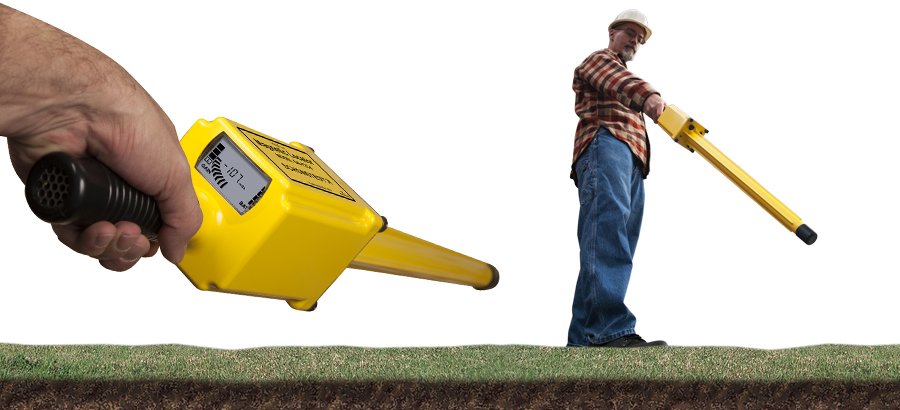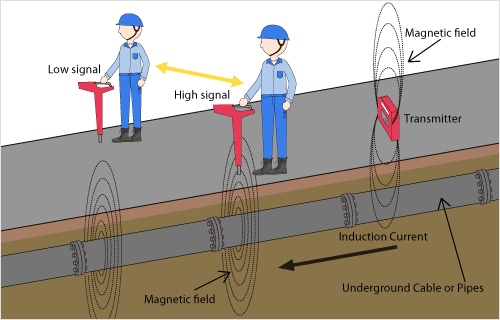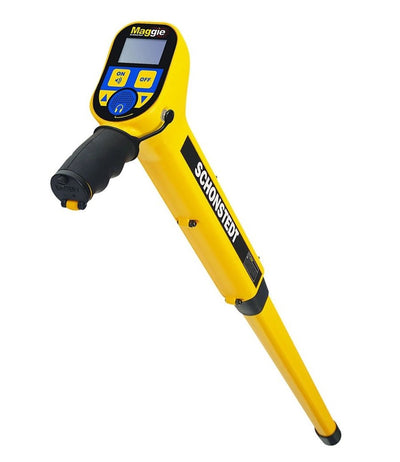All over the world, there are things that are not visible to the naked eye. Some of these things are either intentionally or unintentionally buried underneath the ground’s surface. While some people spend their free time searching for buried items, others look for these objects as part of their professions.
Digging holes in one plot of land after another just to find buried things is, needless to say, impractical. Not only will this ruin the landscape, but it will also be a tremendous waste of time. For this task, hobbyists and professionals alike should use a specialized tool called an underground locator.
- I. What Are Underground Locators?
- II. History
- III. Main Parts
- IV. How Do They Work
- V. Methods of Active Locating
- VI. Advantages
- VII. Types of Underground Locators
- 1. Hum Detectors
- 2. Radio Frequency Detectors
- 3. Transmitter/Receiver Instruments
- 4. Metal Detectors
- 5. Ground-Penetrating Radar
- VI. Choosing the Right Underground Locator
What Are Underground Locators?
Some might call it a magnetic or electromagnetic detector, while others use the term cable locator. No matter how people call this tool, it is designed to find things buried underground. There are underground locators with features that allow them to detect ferrous materials. There are also locators that make use of other methods for locating buried objects.
Underground locators come in handy for professionals in various industries. Construction professionals, in particular, use these locators to search for buried utility lines to avoid accidents during excavation. In general, underground utility locators can accurately trace cables, electrical lines, gas lines, water pipes, wires, fire systems, survey markers, and many more.
History
The origin of underground locators can be traced back to the concept of dowsing rods. Although some consider these rods as pseudoscience, they are used for locating buried ore, metals, oil, water, and many others. However, today’s underground locators can be attributed to 19th-century science rather than pseudoscience and divination.
In the year 1831, Michael Faraday discovered electromagnetism, a principle around which the design of underground locators revolves. Electromagnetic technology was then used for locating buried cables in 1910, which is the earliest record of the existence of underground locators. During that time, the locator used was a wooden truss with a winding coil.
After that revolutionary discovery, professionals have been working on improving this useful tool’s design. There were the Metallascope or an aircraft radio direction finder invented in 1920 and the Depthometer with a twin sensing aerial antenna designed in 1964.
The modern underground locator makes use of multiple frequencies, electronic depth measurement, and other features and accessories. By combining active and passive signals, today’s underground locators can quickly find buried utilities.
Main Parts
Nowadays, there are underground locators with different features, components, and accessories. In spite of this, most underground locators consist of two parts: a transmitter and a receiver.
An underground locator’s transmitter is designed to generate a selected frequency or signal. By applying that signal to a buried utility line, the transmitter can determine that utility line’s location.
The receiver, on the other hand, detects the signals coming from the transmitter. This component enables the user to view the location of underground pipes and cables.
How They Work
The most effective type of underground locator is the electromagnetic utility detector, which is why it is also the most commonly used. With the use of electromagnetic technology, this locator can effectively detect subsurface utilities. It works by searching for the magnetic field that surrounds utility lines. This magnetic field is typically produced by a radio frequency, which can exist in two ways. It can occur naturally or passively, or it can be actively induced by the underground locator’s transmitter.

1. Passive Signals
Passive signals are naturally present around some types of utility lines, like cable television lines or power cables generating 50/60-hertz electric energy. Aside from this, there are also passive signals coming from low frequencies transmitted by radios. These radio frequencies or wave transmissions go through the ground and flow along buried utility lines. Passive signals thus allow utility lines to be detected by underground locators. However, these locators won’t be able to recognize the specific type of utility line. Since the same passive signals might be present on other types of utility lines, it will be difficult for underground locators to identify the utility line.
2. Active Signals
Passive signals are naturally produced, whereas active signals are deliberately generated by the users of underground locators. Active signals are produced with the use of a transmitter of an underground locator. These signals are alternating currents applied from the transmitter to the buried utility lines. Unlike passive signals, they allow locators to accurately identify the type of utility line underneath.
Methods of Active Locating
The method of locating passive signals is a lot less accurate than the active method. In fact, when professionals use the passive method alone, approximately 60% of buried utility lines will not be found. Moreover, using the passive method of locating might result in misidentifying utility lines. When it comes to locating utility lines, the active method offers the most precision.
There are different ways of applying active signals on underground utility lines. The methods of active locating include direct connection, induction, and signal clamping.
1. Direct Connection
Among the three methods, the direct connection method is the most accurate and the most commonly used for detecting utility lines. Basically, in this procedure, the underground locator directly applies an electromagnetic radio frequency to the underground utility line.
To do this method, the connection lead of the locator’s transmitter is connected directly to the access point of the target utility line. A few examples of this access point are utility boxes, fire hydrants, meters, and valves.
After connecting the first lead to the access point, the circuit is completed by connecting the transmitter’s second lead to the ground. Finally, the transmitter is adjusted to match the frequency of the target utility line. The receiver is also adjusted to the same frequency as the transmitter so that the receiver can trace and identify the utility line.
2. Induction
When the target utility line has no access point above the surface, the induction method of active locating can be used. Since this method does not make use of physical connections, it can be considered a quick way to apply active signals on utility lines.
In the induction method, the underground locator is placed on the ground. The locator then produces a magnetic field into the ground’s surface to locate the utility line.
The induction method can also be used for detecting unknown or abandoned utility lines. In spite of this, it is the least preferred method of active locating since it can cause electromagnetic coupling or bleeding off. This means that the underground locators can detect other buried utilities buried in the vicinity, which results in inaccurate identification of utilities.
3. Signal Clamping
Like the direct connection method, the signal clamping method can yield precise results as well. The difference is that the clamping method neither makes use of electrical contact with the utility line nor requires grounding the transmitter. This method makes use of a split toroidal magnetic core or clamp instead of connection leads. This clamp connects the transmitter to the utility line. The setup allows the signal from the transmitter to flow through the coil and to the target utility line. The receiver is then adjusted to the same frequency as the transmitter.
Compared to the direct connection method, signal clamping is more convenient and accurate. This method does not require grounding and electrical contact with the utility line, both of which can be time-consuming. It also allows underground locators to detect the strong signals applied to the target utility line while preventing the signals from bleeding off.

Advantages
Using underground locators brings so many convenient advantages to professionals and communities. The most obvious advantage is the prevention of future accidents. Since underground locators can search for buried pipelines, excavators can avoid digging around those areas and accidentally hitting the pipelines.
Damaging utility lines is not just costly, but it also poses dangerous risks. They might cause toxic substances to leak and contaminate the soil. They might even result in gas explosions. With the use of underground locators, all of these hazards can be prevented, thus boosting the overall safety of the construction site.
Since these locators make use of electromagnetic technology, they can search the areas to find buried utility lines effectively. In addition to this, some locators can identify the specific types of utility lines that they locate. Other locators can even check for water leaks in pipes, coating conditions of pipelines, and cable faults. That’s why users of underground locators can conveniently collect the information about the underground utilities, even from above the surface. The information collected by underground locators can help professionals plan the layout of a construction site.
Another great thing about using underground locators is that they can measure the depths of the buried utility lines from the surface. They are also designed to be portable, so users can easily handle and carry them anywhere. Moreover, they work in any soil condition, and some locators can even work underwater.
With underground locators, users can conveniently adjust the radio frequencies as well as the power output of their locators’ transmitters. They can also easily control both the grounding location and connection point of their transmitters. Given these features, underground locators help improve the efficiency and accuracy of the job.
Types of Underground Locators
Over a century has passed since the invention of the first underground locator. That’s why today, various types of underground locators and cable locators exist. They make use of different technologies, and they are constructed or assembled differently. When deciding which underground locator to use for the job, knowing the main types of these locators can go a long way.
1. Hum Detectors
Hum detectors are called so due to the fact that they produce a steady audible hum whenever they detect underground cables. They are only considered receiving instruments since they don’t make use of transmitters. Hum detectors can only locate live lines or electrical cables that radiate magnetic fields, so they cannot detect direct current cables. Moreover, they do not respond to cables with little or no current flow, such as the cables of street lights during the day when these lights are not in use.
2. Radio Frequency Detectors
Like hum detectors, radio frequency detectors can also be considered receiving instruments. Since they do not have transmitters, they can only detect low-frequency radio signals coming from metallic pipelines and cables. Other than this, they can also detect abandoned pipelines and tram tracks that radiate these signals.
3. Transmitter/Receiver Instruments
Compared to hum detectors and radio frequency detectors, transmitter/receiver instruments are more accurate and effective at locating buried utilities. They come in handy when these other detectors are not successful at finding buried lines. Because transmitter/receiver instruments have transmitters, they can apply active signals to utility lines. When these instruments’ receivers are calibrated to the same frequency as the transmitters, these receivers can effectively detect the active signals.
Transmitter/receiver instruments can be directly connected to the pipelines or placed near these lines to apply the active signals. That’s why users should know beforehand the location of at least some part of the utility line. This way, they can properly place their transmitters in position. Although it isn’t required to connect this type of locator to a utility line directly, doing so can significantly enhance its accuracy.
4. Metal Detectors
Metal detectors are just what they sound like—they can locate buried metal objects nearby. These are conventional detectors used by hobbyists and professionals in various industries. In construction, they can locate manhole covers, survey markers, joint boxes, and other objects made of metal. The problem with this type of underground locator is that it is not effective at finding underground utility lines.

5. Ground-Penetrating Radar
Underground locators with ground-penetrating radars can detect metallic and non-metallic objects buried underneath. Ground-penetrating radar is a method that uses radar pulses to detect anomalies underground. The sources of these anomalies, especially when they’re positioned in a continuous line, can point to underground pipelines. However, ground-penetrating radar tends to be more expensive than other methods. Unlike transmitter/receiver instruments, it cannot accurately identify the specific type of underground utility. It also requires trained specialists to operate locators using ground-penetrating radars.

Choosing the Right Underground Locator
Before getting an underground locator for the job, there are a few things that should first be considered. One of these things is the ground conditions of the job site. If the terrain poses difficulties in locating utilities, the underground locator should be up for the challenge.
If it’s possible to gather any information about the target utility line, then gather away. It will be extremely beneficial for the project to know the type, length, and depth of the underground utility line. Knowing the level of electrical current flowing through cables can also help. Having all of these pieces of information can significantly save time and effort spent on locating utility lines.
Another thing to consider before getting an underground locator is the level of training, skill, and experience of the operator. The user should know how to operate and calibrate the underground locator properly.
The presence of a signal generator or a transmitter in the underground locator is also worth considering. Using a locator with a transmitter can improve the accuracy of detecting and identifying underground utilities.
When it’s time to use an underground locator, make sure to use it according to the instructions of the manufacturer. For optimal use of the device, it’s best to check and calibrate it on a regular basis.
If you’re currently deciding which underground locator is the best for the job, look no further than Engineer Warehouse. We have carefully collected the best underground locators out there. Rest assured that they are made by top manufacturers in the industry, so they offer the latest features of locators. With a wide selection of underground locators, you’ll definitely find the right one that will meet the demands of your project.












